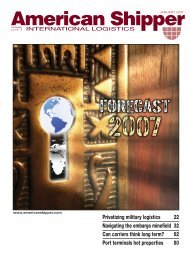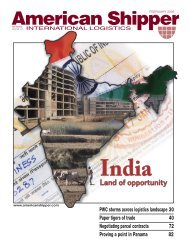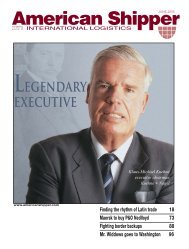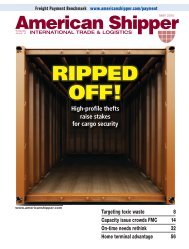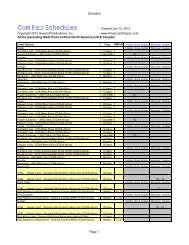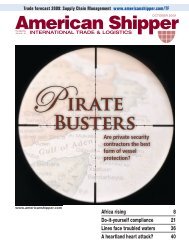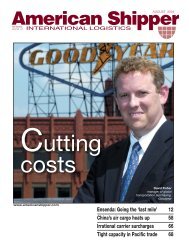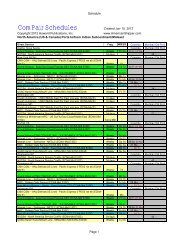McLean's - American Shipper
McLean's - American Shipper
McLean's - American Shipper
- No tags were found...
Create successful ePaper yourself
Turn your PDF publications into a flip-book with our unique Google optimized e-Paper software.
12 AMERICAN SHIPPER: APRIL 2006doned the idea thathad taken root inJersey City. Yet hecertainly knew thatothers were usingships to carry boxedcargo.For example, bythe end of WorldWar II, the U.S.Army TransportationCorps haddeveloped “the Conex”(for “containerexpress”), a reusablesteel container inseveral sizes — themedian being sevenfeet high and six feetwide. A commercialversion was calledthe Dravo Transportainer.Conex boxeswere used extensivelyin the KoreanWar. Upon arrivingat their destination,most of them servedas command postsor field housingfor troops. The U.S.military switched tostandard containersfor larger loads inthe 1970s.In 1945 AndrewJackson Higgins,another shippingentrepreneur, proposedusing 10- and20-foot long containerscarried on truck chassis, railcars, ships and barges.Higgins Industries, a New Orleans-based company that hadmade landing craft for Allied forces during World War II, wouldprovide such containers. After a run of bad business luck, Higginsdied in 1952.In 1953, the Alaska Steamship Co. started carrying containersbetween Seattle and Anchorage on Liberty ships and C-1freighters fitted with squared-off holds. The containers werecollapsible boxes stowed below deck and on deck.In 1955, the White Pass & Yukon Railway shipped 25-footcontainers between the Yukon Territory and Vancouver, BritishColumbia, on a vessel called the Clifford J. Rogers.By then, McLean’s own plans were well afoot. “In 1954,McLean held a seminar for his company’s employees to explainthe “sea-land” concept to them, and that was two years before theIdeal X sailed,” Paul F. Richardson told <strong>American</strong> <strong>Shipper</strong>.Richardson, who started working for McLean Trucking in1952 after graduating from college, became the company’s toprankedsalesman,and later presidentof Sea-Land ServiceInc., from 1969to 1976. He is now aprincipal with PaulF. Richardson AssociatesInc., basedin Holmdel, N.J.“We tend toforget today thatMcLean Truckingwas an astonishinglysuccessfuloperation,” he explained.In less thana decade, McLean’scompany had becomethe largestmotor freight carrieroperating in theSouth.”In 1950, McLeanordered 600 GeneralMotors dieseltractors with sleepercabins to be deliveredin two years— the largest orderGM had received atthat time.McLean’s driverswere singlemindedon keepingtheir schedules. Inthose years, longbefore the Interstatehighway system,drivers working forMcLean’s competitorsreferred to themiddle or passinglane on three-lane highways as “the McLean Lane.” Hiscompany’s trucks used it whenever possible as a driving lane,instead of one meant for passing other vehicles.McLean generously rewarded drivers with exemplary safetyrecords. He once offered a furnished house worth $25,000 asa prize for a trucker on his payroll with the best driving recordfor the next year.Upon learning that the eventual winner had gone 80,000miles without a scratch or dent on his rig, McLean canceledhis freight insurance, saving more money on premiums that hehad paid for prizes for his drivers.Workers at Bethlehem Shipyard hoist a McLean Trucking trailer on June 22,1955, experimenting with how to load and unload trailers aboard vessels.(Photo courtesy of Capt. James McNamara collection, originally published in <strong>American</strong> <strong>Shipper</strong> May 1996)A useful man in the streetBy 1952, McLean knew that the easy days of long-haul truckingwere over. States were imposing “highway use” taxesbased on weight and mileage. In particular Virginia, throughwhich McLean’s trucks had to cross on some of their busiest



